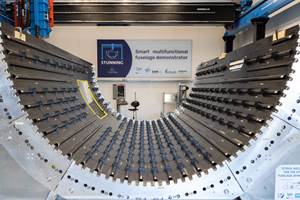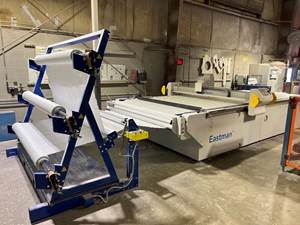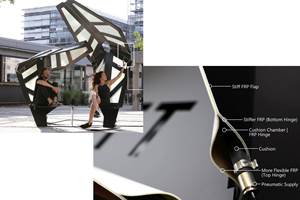Stratasys debuts Robotic Composite and Infinite-Build 3D printers
The company says this new 3D printing technology produces larger, lighter production parts for aerospace and automotive.
Stratasys Inc. (Minneapolis, Minn.) has launched two new pieces of additive manufacturing technology: Robotic Composite 3D Demonstrator and Infinite-Build 3D Demonstrator. The company will preview both technologies during the upcoming IMTS 2016 (Sept. 12-17; Chicago).
Stratasys developed the Robotic Composite 3D Demonstrator integrating its core additive manufacturing technologies with industrial motion control hardware and design–to-3D printing software capabilities provided by Siemens (Washington, DC). This Robotic Composite 3D Demonstrator is designed for the 3D printing of composite parts.
The Robotic Composite 3D Demonstrator delivers “true” 3D printing by using an 8-axis motion system that enables precise, directional material placement for strength while also reducing the need for speed-hindering support strategies.
The Stratasys Infinite-Build 3D Demonstrator is designed to address the requirements of aerospace, automotive and other industries for large lightweight, thermoplastic parts with repeatable mechanical properties. The Infinite-Build 3D Demonstrator features a new approach to FDM extrusion that reportedly increases throughput and repeatability. The system’s “infinite-build” approach prints on a vertical plane for practically “unlimited part size in the build direction,” the company claims.
Aerospace giant Boeing (Everett, Wash.) played an influential role in defining the requirements and specifications for the demonstrator, according to Stratasys. Boeing is currently using an Infinite-Build 3D Demonstrator to explore the production of low volume, lightweight parts. Ford Motor Co. (Dearborn, Mich.) is also exploring new automotive manufacturing applications for this demonstrator, and will evaluate this new technology. Ford and Stratasys will work together to test and develop new applications for automotive-grade 3D printed materials that were not previously possible.
“Additive manufacturing represents a great opportunity for Boeing and our customers, so we made a strategic decision more than a decade ago to work closely with Stratasys on this technology. We are always looking for ways to reduce the cost and weight of aircraft structures, or reduce the time it takes to prototype and test new tools and products so we can provide them to customers in a more affordable and rapid manner. The Stratasys Infinite-Build 3D Demonstrator enables products to be made at a much larger and potentially unlimited length, offering us a breakthrough tool to add to our robust additive manufacturing processes,” says Darryl Davis, president of Boeing Phantom Works.
In addition to the Infinite-Build and Robotic Composite 3D Demonstrators being featured in technology demonstrations, Stratasys will showcase at ITMS 2016 examples of 3D printing applications used today by its customers for tooling and manufacturing processes, including 3D printed jigs & fixtures, composite tooling, mold tooling and production parts.
“Stratasys is building on our success in manufacturing with applications such as manufacturing aids, injection molds and composite tooling, and leveraging our relationships with innovative industry leaders to further extend the applicability of additive manufacturing in demanding production environments,” says Ilan Levin, CEO of Stratasys. “We view the level of factory integration, automation, and performance monitoring potentially offered by these new demonstrators as catalysts for the transformation to Industry 4.0. Stratasys invites all visitors to IMTS to see these new technologies, as well as our field-proven industrial additive manufacturing solutions, in action.”
Here's a video of the new technology:
Related Content
Thermoplastic composites welding: Process control, certification, crack arresters and surface prep
More widespread use of welded composite structures within a decade? Yes, but further developments are needed.
Read MoreFiberglass Cutting Operation at Hubbell’s Lenoir City Plant Moves to Automation
Automating fabric cutting operations saves Hubbell Lenoir City money and can produce composite products faster at less cost to support infrastructure expansion.
Read MoreSiemens Gamesa, Airborne collaborate on automation of wind turbine blades
Joint efforts combine years of expertise in the manufacture of wind turbine blades, composite processing and automation to scale up operations.
Read MoreAdaptive composite elements for building facades exhibited at JEC World 2023
University of Stuttgart institutes use carbon and glass fiber composites, robotic fabrication, biomimetic design and digial twin/control to demonstrate adaptive facade elements for future buildings.
Read MoreRead Next
CW’s 2024 Top Shops survey offers new approach to benchmarking
Respondents that complete the survey by April 30, 2024, have the chance to be recognized as an honoree.
Read MoreComposites end markets: Energy (2024)
Composites are used widely in oil/gas, wind and other renewable energy applications. Despite market challenges, growth potential and innovation for composites continue.
Read MoreFrom the CW Archives: The tale of the thermoplastic cryotank
In 2006, guest columnist Bob Hartunian related the story of his efforts two decades prior, while at McDonnell Douglas, to develop a thermoplastic composite crytank for hydrogen storage. He learned a lot of lessons.
Read More

























